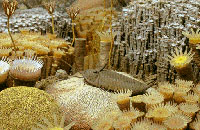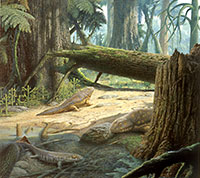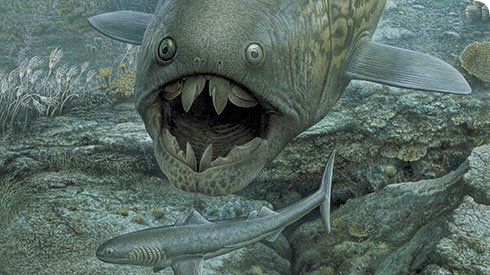Late Devonian mass extinction
Following the end-Ordovician mass extinction, the diversity of many of the affected marine invertebrate groups increased again. Fish became a prominent part of marine and freshwater fauna. The Devonian Period is known as the Age of Fishes.
On land, plants continued to spread and diversify. By the Devonian, the first forests had appeared, as well as primitive insects and the precursors of amphibians.
But this evolutionary boom was followed by another series of catastrophic extinctions.
When did it happen?
About 375-359 million years ago.
The latest research suggests the extinctions occurred in 2 main phases - the first lasting about 2 million years and the latter about 1 million years. However, some scientists recognise several pulses of extinctions spread across 15-20 million years.

Corals suffered badly in the Late Devonian mass extinction. Extensive reef ecosystems collapsed. © Carl Wozniak
What went extinct?
22% of all marine families, 57% of all genera, an estimated 79-87% of all species.
Armoured fish (ostracoderms and placoderms) vanished completely. Plants and insects suffered remarkably few extinctions but there was a significant impact on most marine groups.
Shallow tropical oceans were particularly badly affected. Reef ecosystems ceased to exist and no new ones were built for the next 100 million years.
Causes
The causes of this drawn-out mass extinction are far from certain, but it was a time of major environmental change. The first phase has been linked to a lack of oxygen in the ocean (anoxia), combined with rising sea levels and global cooling.

The appearance of forests may have played a role in the mass extinction 375-359 million years ago. © John Sibbick, Natural History Museum
Some scientists think that the increased diversity and amount of plant cover on land triggered the anoxia and cooling.
New plant root systems boosted soil formation and promoted the weathering of rocks, releasing nutrients into the oceans. This may have stimulated algal blooms that used up oxygen in the water when they decayed. Meanwhile, photosynthesising plants and the weathering of silicate rocks would have reduced the amount of the greenhouse gas carbon dioxide in the atmosphere, causing temperatures to fall.
Large volcanic eruptions in the Vilnuy Province in eastern Siberia may have also induced climate change. Large meteor impacts have been blamed too. But, although glassy globules of melted rock tell us that impacts did occur in the Late Devonian, so far none match the timing of the extinctions.
Many experts believe that an intense ice age, brought about by the supercontinent Gondwana drifting back over the South Pole, is responsible for the later round of extinctions.
Find out how life recovered and when the next mass extinction hit
Toolbox
The Great Extinctions book

What are the processes responsible for species extinction? And are we about to cause another mass extinction? Find out in this in-depth guide by Museum expert, Professor Norman MacLeod.
